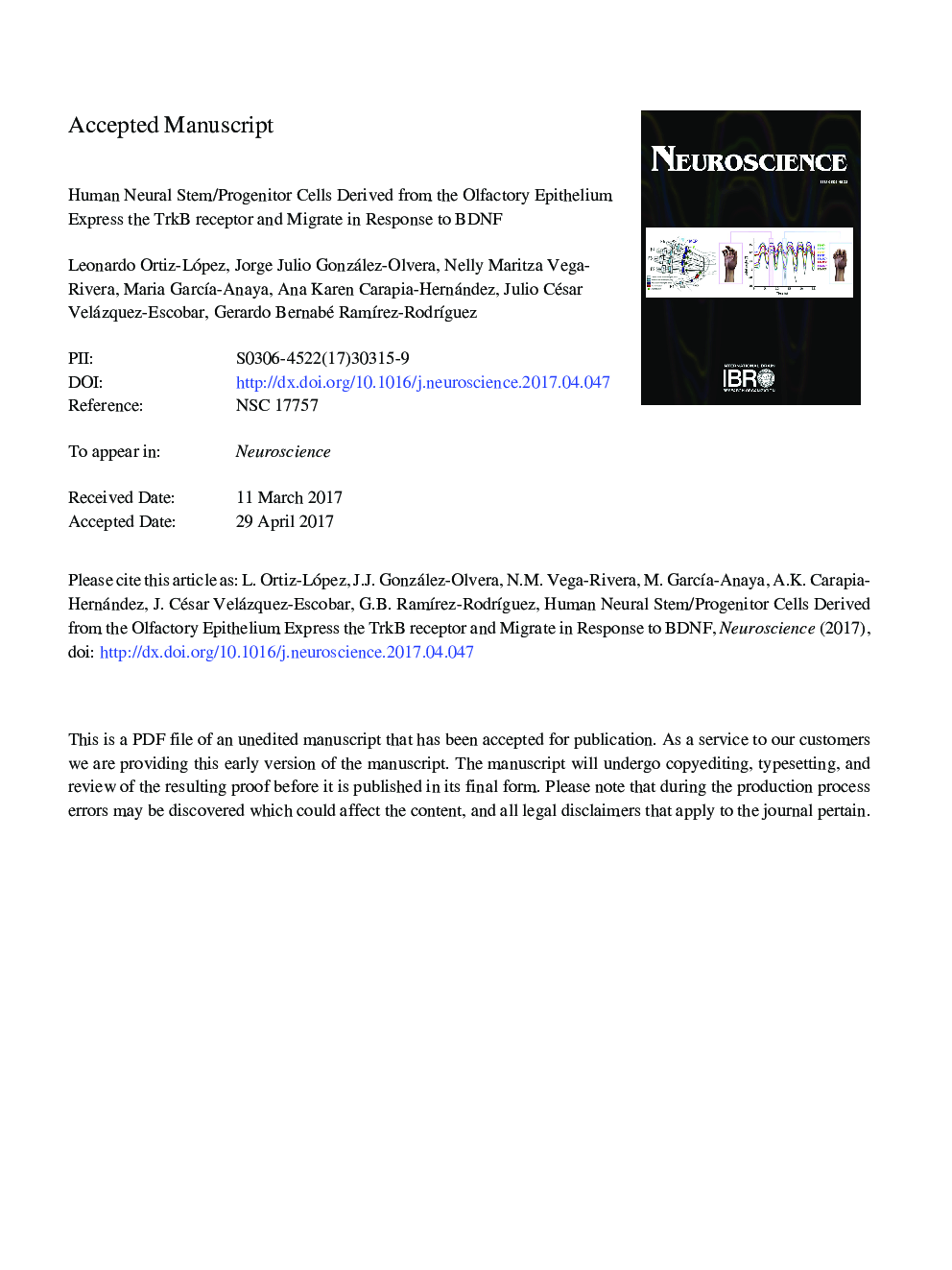| کد مقاله | کد نشریه | سال انتشار | مقاله انگلیسی | نسخه تمام متن |
|---|---|---|---|---|
| 5737609 | 1614721 | 2017 | 47 صفحه PDF | دانلود رایگان |
عنوان انگلیسی مقاله ISI
Human neural stem/progenitor cells derived from the olfactory epithelium express the TrkB receptor and migrate in response to BDNF
دانلود مقاله + سفارش ترجمه
دانلود مقاله ISI انگلیسی
رایگان برای ایرانیان
کلمات کلیدی
VinculinTrkBPKCBDNF - BDNF یا فاکتور نورونزایی مشتقشده از مغز olfactory epithelium - اپیتلیوم بویاییneural stem/progenitor cells - سلول های بنیادی عصبی / پیش سازBrain-derived neurotrophic factor - فاکتور نوروتروفی مشتق شده از مغزMigration - مهاجرتadult neurogenesis - نوروژنز بزرگسالانProtein kinase C - پروتئین کیناز سیtyrosine receptor kinase B - گیرنده تریروزین کیناز ب
موضوعات مرتبط
علوم زیستی و بیوفناوری
علم عصب شناسی
علوم اعصاب (عمومی)
پیش نمایش صفحه اول مقاله

چکیده انگلیسی
Neurogenesis constitutively occurs in the olfactory epithelium of mammals, including humans. The fact that new neurons in the adult olfactory epithelium derive from resident neural stem/progenitor cells suggests a potential use for these cells in studies of neural diseases, as well as in neuronal cell replacement therapies. In this regard, some studies have proposed that the human olfactory epithelium is a source of neural stem/progenitor cells for autologous transplantation. Although these potential applications are interesting, it is important to understand the cell biology and/or whether human neural stem/progenitor cells in the olfactory epithelium sense external signals, such as brain-derived neurotrophic factor (BDNF), that is also found in other pro-neurogenic microenvironments. BDNF plays a key role in several biological processes, including cell migration. Thus, we characterized human neural stem/progenitor cells derived from the olfactory epithelium (hNS/PCs-OE) and studied their in vitro migratory response to BDNF. In the present study, we determined that hNS/PCs-OE express the protein markers Nestin, Sox2, Ki67 and βIII-tubulin. Moreover, the doubling time of hNS/PCs-OE was approximately 38 h. Additionally, we found that hNS/PCs-OE express the BDNF receptor TrkB, and pharmacological approaches showed that the BDNF-induced (40 ng/ml) migration of differentiated hNS/PCs-OE was affected by the compound K252a, which prevents TrkB activation. This observation was accompanied by changes in the number of vinculin adhesion contacts. Our results suggest that hNS/PCs-OE exhibit a migratory response to BDNF, accompanied by the turnover of adhesion contacts.
ناشر
Database: Elsevier - ScienceDirect (ساینس دایرکت)
Journal: Neuroscience - Volume 355, 4 July 2017, Pages 84-100
Journal: Neuroscience - Volume 355, 4 July 2017, Pages 84-100
نویسندگان
Leonardo Ortiz-López, Jorge Julio González-Olvera, Nelly Maritza Vega-Rivera, Maria GarcÃa-Anaya, Ana Karen Carapia-Hernández, Julio César Velázquez-Escobar, Gerardo Bernabé RamÃrez-RodrÃguez,